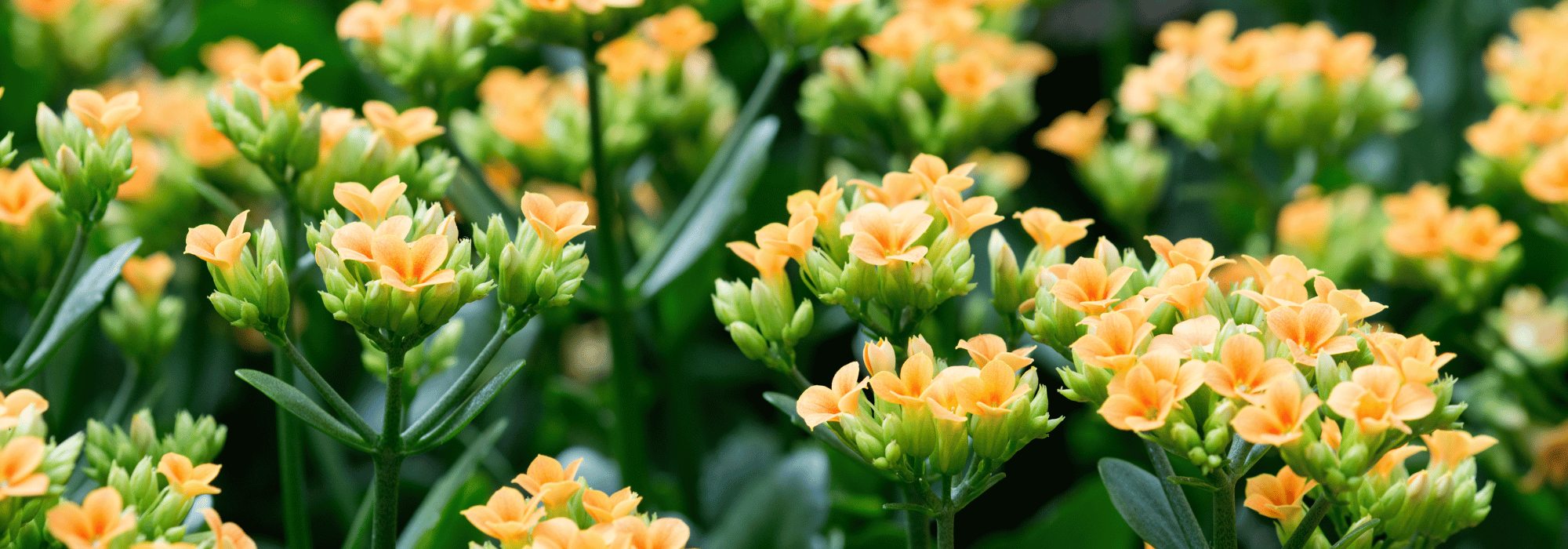
Kalanchoe : cultivation and care
Contents
The kalanchoe in a few words
- The kalanchoe is an easy-to-care-for succulent plant, perfect for indoors thanks to its fleshy foliage and colourful flowering.
- It thrives in light, well-draining soil and requires moderate watering to avoid excess moisture.
- Propagation is simple through propagation by cuttings or via seedlings in some species.
- In terms of decor, it adapts to all styles, from bohemian to modern, depending on the choice of pot.
- Hardy, it can nonetheless be susceptible to root rot if drainage is poor.
The word from our expert
The kalanchoe, a prominent member of the Crassulaceae family, is a fleshy plant prized for its easy care and sometimes vibrant flowering. Native to the arid regions of Africa and Madagascar, it adapts perfectly to indoor cultivation thanks to its fleshy leaves that store water. Available in a wide range of species and varieties, from the fuzzy foliage of Kalanchoe tomentosa to the broad rosettes of Kalanchoe thyrsiflora, it charms as much for its aesthetics as for its hardiness. But when we talk about “kalanchoe,” we immediately think of Kalanchoe blossfeldiana, the most popular species with its vivid flowers (red, pink, yellow, orange…) and its long-lasting flowering.
Easy to grow, the kalanchoe thrives in well-draining soil and bright light, without excess moisture. Moderate watering, allowing the soil to dry out between waterings, is enough to ensure its health. To encourage flowering, a suitable fertiliser can be added in spring and summer. Some species propagate easily by propagation by cuttings or by the seedlings that grow on the leaves, as with the Kalanchoe daigremontiana.
In terms of decoration, this versatile succulent fits into all interior styles, from minimalist to bohemian. A terracotta pot will highlight its natural hues, while a colourful ceramic container will add a contemporary touch.
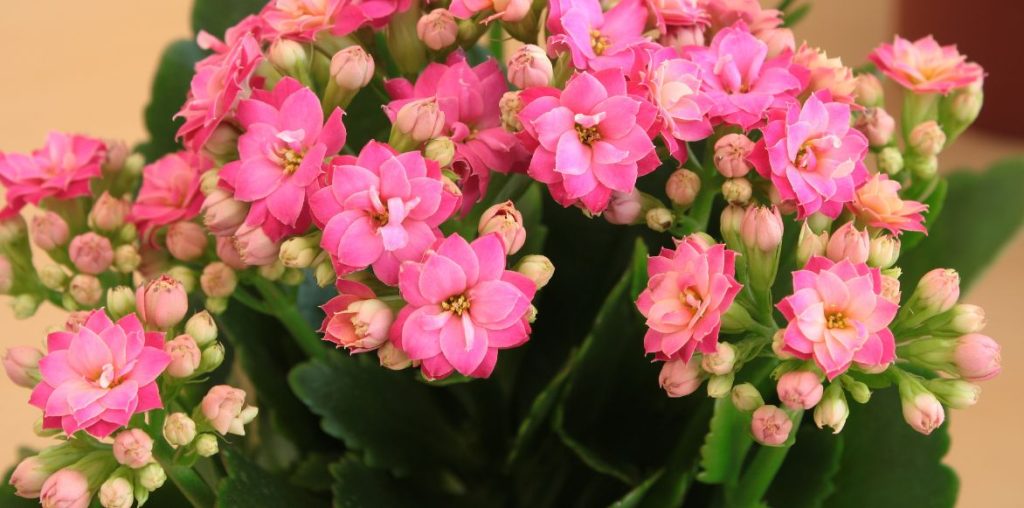
The semi-double pink flowering of a variety of Blossfeld’s Kalanchoe.
Botany and description
Botanical data
- Latin name Kalanchoe sp.
- Family Crassulaceae
- Common name Kalanchoe, Kalanchoë
- Flowering November to February
- Height up to 1.50 m
- Exposure bright, no direct sunlight
- Soil type light, well-drained
- Hardiness frost-sensitive
The Kalanchoes belong to the large Crassulaceae family, known for its succulent plants adapted to arid environments. Their genus name, Kalanchoe, originates from a Latin transcription of a Chinese word, likely linked to the ability of some species to reproduce spontaneously through propagation by cuttings or the seedlings that grow on their leaves.
In French, these plants are commonly called Kalanchoes, but also “fleurs de fortune” or “plantes de Goethe,” due to the German poet and scientist’s interest in their astonishing mode of reproduction. In their natural habitat, they thrive mainly in the warm, dry regions of Africa and Madagascar, as well as in parts of Asia. Their ability to store water in their fleshy leaves and their resistance to drought conditions make them champions of adaptation.
Their popularity as houseplants is largely due to their abundant and colourful flowering, which can last several weeks, particularly in the case of Kalanchoe blossfeldiana or Blossfeld’s Kalanchoe, the most widespread species in garden centres, available in various flower colours (red, orange, yellow, white, purple…) and even sometimes double blooms. Their ease of care also plays a key role: Kalanchoes tolerate missed waterings and thrive in bright environments without requiring much attention.
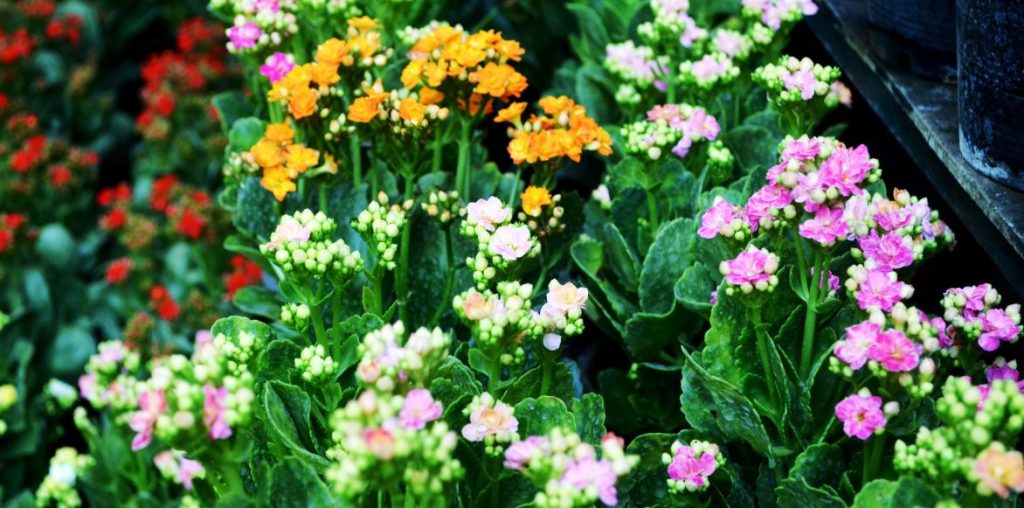
The classic Kalanchoe, known as Blossfeld’s Kalanchoe, comes in various colours.
Among the most popular species and varieties in cultivation are the Kalanchoe beharensis ‘Oak Leaf’, with spectacular foliage resembling velvety oak leaves, and the Kalanchoe beharensis ‘Fang’, recognisable by its toothed leaves adorned with small protrusions. The Kalanchoe marmorata, with its large marbled leaves, adds a graphic touch to interiors, while the Kalanchoe oricula charms with its thick, rounded ear-shaped leaves. The Kalanchoe thyrsiflora, sometimes confused with Kalanchoe luciae, stands out for its rosettes of broad leaves with red edges, which take on spectacular hues under intense light.
Did You Know?: The name Bryophyllum was once used to refer to certain Kalanchoe species, particularly those capable of producing seedlings on the edges of their leaves, such as the Kalanchoe daigremontiana or the Kalanchoe pinnata. This name comes from the Greek bryo (to sprout) and phyllon (leaf), referencing this unique vegetative reproduction ability. Today, botanists have integrated these species into the Kalanchoe genus, although the old name is still used by some horticulturists.
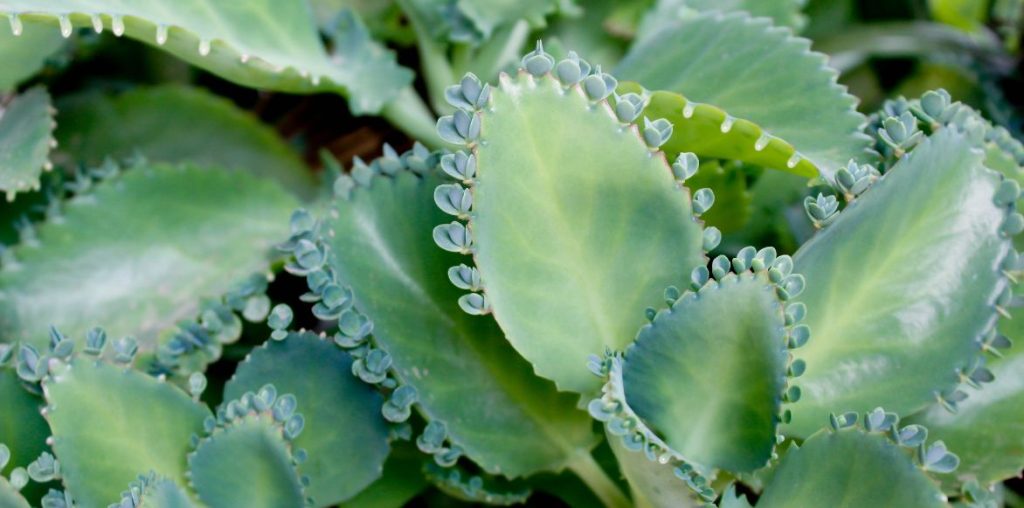
Young seedlings developing around the edge of a Kalanchoe daigremontiana leaf
Kalanchoes exhibit great morphological diversity, ranging from small herbaceous plants to true succulent bushes. Their habit varies by species: some, like the Kalanchoe thyrsiflora, adopt a compact rosette form with thick leaves arranged in a spiral, while others, like the Kalanchoe beharensis (such as the variety ‘Subnuda’), can reach several metres in height with a more upright and branched habit.
The root system is generally shallow, adapted to the well-draining, poor soils of their natural habitat. These fibrous and relatively fragile roots allow them to quickly absorb water after rare rains but make them sensitive to excess moisture. In some species, like the Kalanchoe pinnata, adventitious roots can even appear on stems and fallen leaves, aiding their propagation.
The trunk, when present, is often woody at the base and becomes more succulent towards the tips. The branches, where they exist, are fleshy and brittle, as in the Kalanchoe tomentosa, a bushy species whose stems become lignified with age. In shrubby forms like the Kalanchoe beharensis, the thick stems store water and sometimes exhibit a nodose appearance with slightly peeling bark.
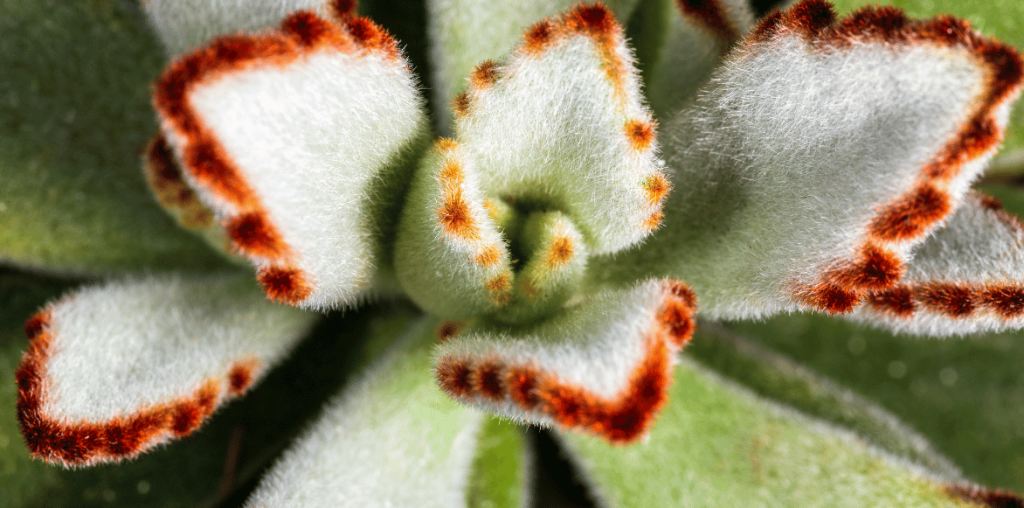
The velvety foliage is clearly visible on this Kalanchoe tomentosa
The foliage is generally fleshy, covered with a thick cuticle that limits evaporation, and takes on very varied forms. The Kalanchoe tomentosa, for example, has elongated, velvety leaves covered in thick silver fuzz, with edges adorned with small brown spots. In contrast, the Kalanchoe daigremontiana produces lanceolate leaves with toothed edges, where numerous seedlings capable of detaching and rooting form.
The flowering of Kalanchoes is spectacular and prolonged, often occurring in winter or spring, with inflorescences in panicles or cymes. The Kalanchoe blossfeldiana, the most well-known, is particularly prized for its small, dense bouquet-like flowers, while the Kalanchoe thyrsiflora develops a tall flower spike bearing yellowish urn-shaped flowers.
Note that Blossfeld’s Kalanchoe requires short days to flower, which is why it blooms in winter indoors. However, horticulturists artificially subject them to short days to sell flowering plants year-round.
After flowering, fruiting is relatively inconspicuous. The fruits are capsules containing very fine seeds, dispersed by wind or water. However, most Kalanchoes are primarily propagated by cuttings or the seedlings developing on their leaves, as is the case with species in the subgenus Bryophyllum (see above), facilitating their rapid spread in nature and cultivation.
Warning! All Kalanchoes are toxic, particularly to animals. They can cause poisoning affecting the nervous and muscular systems. The responsible substances, called bufadienolides, belong to the same family as cardenolides, steroid compounds with cardiotonic effects.
Read also
7 iconic cacti and succulent plantsWhen and how to plant a kalanchoë in a pot?
When to plant a kalanchoe?
The best time to plant a kalanchoe is in spring, when the plant enters its active growth period. It can also be planted in summer, but avoid periods of extreme heat, which could stress the plant immediately after potting.
Where to place a kalanchoe?
Kalanchoe is a light-loving plant. It should be placed in a bright spot, ideally near a south or west-facing window. However, in summer, direct exposure to midday sun can scorch the leaves, especially in species with fuzzy foliage like Kalanchoe tomentosa. In winter, more direct exposure is recommended to compensate for the lack of light.
In terms of temperature, kalanchoe thrives in an environment between 15 and 25°C. It can tolerate occasional lower temperatures (down to 10°C), but below this, its growth slows significantly, and it may suffer. It is very sensitive to frost, which is why it is grown as a houseplant in regions with cold winters.
Ambient humidity should be moderate. An overly humid environment encourages fungal diseases and root rot. It’s best to avoid placing the pot in a bathroom or near a humidifier.
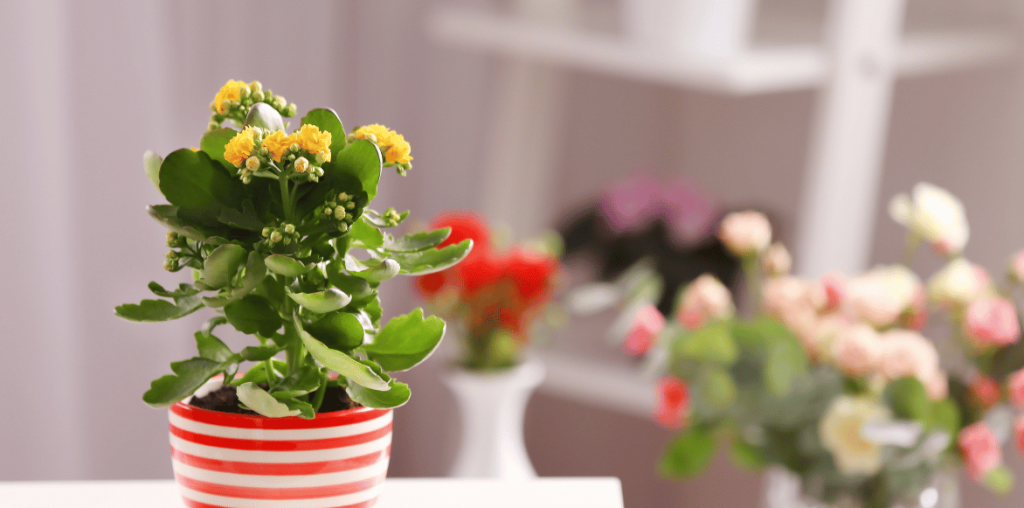
A bright and warm spot is all kalanchoes need to thrive
Which pot to choose?
The pot should be:
- Perforated at the bottom to ensure good drainage and prevent water accumulation.
- Slightly larger in diameter than the root ball (about 2 to 3 cm more), as a pot that’s too large retains too much moisture.
- Preferably made of terracotta, as this porous material promotes water evaporation and reduces the risk of rot. A plastic pot can work, but you’ll need to be more careful with watering.
Which substrate to use?
Kalanchoe needs a well-draining substrate. An ideal mix would be:
- 2/3 cactus and succulent potting mix, or a light universal potting mix.
- 1/3 coarse sand or perlite, to further improve drainage.
- A few clay pebbles or gravel at the bottom of the pot to prevent water stagnation.
How to plant a kalanchoe in a pot?
- Fill the pot with substrate: pour in the potting mix, leaving enough space for the root ball.
- Gently remove the plant from its pot: tap the sides of the original pot to loosen the roots without breaking them. If they’re too tight, gently tease them apart with your fingers.
- Place the kalanchoe in the centre of the new pot: adjust the height so the base of the leaves sits just above the substrate.
- Fill in with potting mix: add more around the root ball without compacting too much to allow air circulation.
- Water lightly: moisten the substrate with a fine-spout watering can, without soaking the soil. The first watering should be moderate, as the roots need to adjust to their new environment.
- Place the plant in its final spot: in a bright location, but avoid intense direct sunlight for the first few days.
Repotting the kalanchoe
A kalanchoe should be repotted every 2 to 3 years, in spring, when its roots completely fill the pot or the plant seems less vigorous. The process is similar to the initial planting, taking care to choose a slightly larger pot and fresh substrate. If the plant becomes too large and unbalanced, this is also an opportunity to prune it lightly to restore a harmonious shape.
Cultivation and Care of Kalanchoe
Kalanchoes are easy-to-care-for plants, as long as their specific needs for watering, fertilisation, and exposure are met. Their succulent nature allows them to withstand forgotten waterings, but certain precautions are necessary to keep them healthy and prolong their flowering.
Watering: finding the right balance
Kalanchoe requires moderate watering, as its fleshy leaves store water. The golden rule is to let the substrate dry out thoroughly between waterings. During the growth period (spring-summer), watering every 10 to 15 days is sufficient, while in winter, it can be reduced to once a month.
Watering should always be done at the base of the plant, avoiding wetting the leaves to prevent fungal diseases. Stagnant water is the enemy of kalanchoe: always empty the saucer after watering and never leave water at the bottom of the pot. When in doubt, it’s better to underwater than overwater.
Fertilisation: boosting growth and flowering
To stimulate flowering and growth, a light application of fertiliser is recommended. During spring and summer, you can add a liquid fertiliser for flowering plants (diluted to half strength in this case) or cacti every 3 to 4 weeks. In autumn and winter, fertilisation should be stopped to allow the plant to enter dormancy.
Be careful, excess fertiliser can harm the plant! It’s best to use a fertiliser low in nitrogen (N) but rich in phosphorus (P) and potassium (K) to support beautiful flowering.
Pruning: an optional but sometimes useful step
Pruning is not essential for a kalanchoe, but it can be beneficial to stimulate new flowering and maintain a compact shape. After flowering, you can cut off the faded flower stalks to prevent the plant from wasting energy on seed formation.
If the plant becomes too tall or bare at the base, you can pinch it (cut the tips of the stems) to encourage branching and achieve a denser habit. Some species, like Kalanchoe tomentosa or Kalanchoe beharensis, naturally have a bushy habit and don’t require regular pruning.
Precautions to avoid problems
- Beware of excess moisture: This is the main cause of kalanchoe mortality. An overly wet substrate can lead to root rot and fungal diseases.
- Avoid scorching sun: Too much direct exposure in summer can cause leaf burns, especially in varieties with fuzzy foliage like Kalanchoe tomentosa.
- Protect from drafts and cold: Temperatures below 10°C can significantly slow growth and cause yellowing of the foliage.
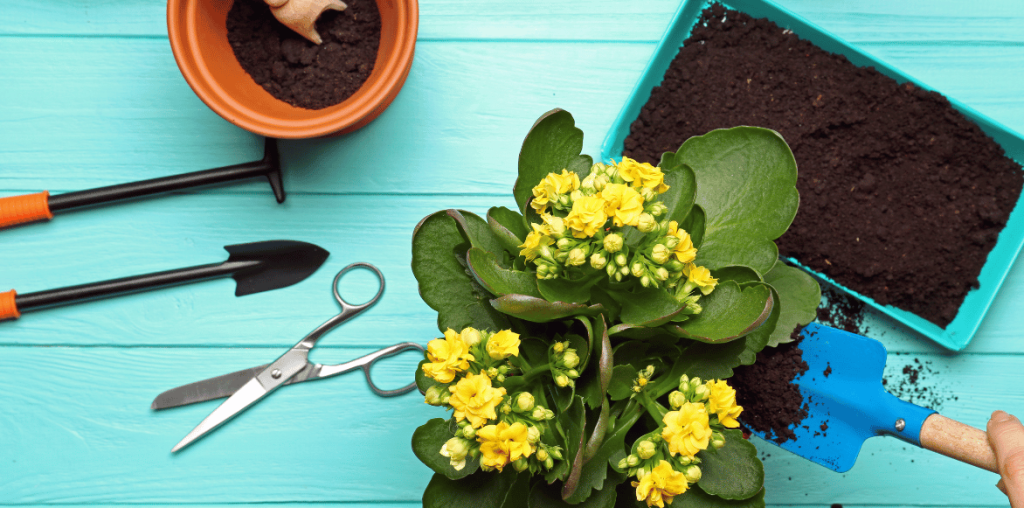
The classic kalanchoe is an easy plant, ideal for beginners
Read also
Propagating cacti and succulentsPotential Parasitic and Disease Issues in Kalanchoe
The Most Common Parasites
- Mealybugs : these small, white, cottony parasites cling to stems and the undersides of leaves, feeding on the sap and weakening the plant. They often appear when the air is too dry. To eliminate them, you can remove them manually with a cotton pad soaked in 70% alcohol or spray a solution of diluted black soap in water.
- Aphids : less common, they attack young shoots and flower buds, deforming them and preventing flowering. A strong jet of water or a treatment with black soap is usually enough to eradicate them.
- Spider mites : these microscopic mites thrive in hot, dry weather, leaving a greyish foliage and sometimes fine webs. Increasing ambient humidity and spraying water on the leaves (without excess) can limit their appearance. In case of infestation, a treatment with nettle purin or black soap is effective.
Common Diseases
- Root rot : this is the most common problem, caused by overwatering or poor drainage. The leaves become soft, turn yellow, and eventually fall off. The only solution is to stop watering, repot the plant in a dry, well-draining substrate, and cut off affected roots if necessary.
- Powdery mildew : this fungal disease manifests as a white powdery deposit on the leaves, due to excessive humidity and lack of ventilation. Isolate the plant and treat with a natural fungicide like diluted milk.
- Leaf spots : these can be caused by fungi or bacteria, often linked to water splashes on the foliage. Avoid watering from above and remove affected leaves.
By maintaining good ventilation, avoiding excess humidity, and regularly monitoring the condition of the leaves, you can greatly reduce the risks of parasitic attacks and diseases in kalanchoes.
How to propagate kalanchoes?
Kalanchoes are easy to propagate and offer several techniques to obtain new plants. Depending on the species, you can use stem or leaf cuttings, division of offsets, or propagation by seedlings, a characteristic unique to certain varieties like Kalanchoe daigremontiana.
Stem cuttings: the simplest and most effective method
Propagation by cuttings is the most commonly used technique for multiplying kalanchoes, especially for species like Kalanchoe blossfeldiana, Kalanchoe tomentosa, or Kalanchoe beharensis.
- Take a cutting: choose a healthy, non-flowering stem and cut a 5 to 10 cm segment using clean, sharp pruning shears.
- Let it heal: allow the cutting to “dry” for 24 to 48 hours in a dry, shaded spot. This step is essential to prevent rotting once planted.
- Plant the cutting: fill a small pot with a light, well-draining substrate (a mix of cactus compost and perlite/sand) and plant the cutting by gently pressing the base into the soil.
- Water lightly: moisten the soil slightly without soaking it. For the first few weeks, keep the plant in a bright spot but out of direct sunlight.
- Monitor growth: within 2 to 3 weeks, roots should appear. Once well-rooted, the kalanchoe can be treated as an adult plant.
Leaf cuttings: a slower but interesting method
Certain species, like Kalanchoe tomentosa or Kalanchoe thyrsiflora, can be propagated by leaf cuttings. Simply detach a healthy leaf, let it dry for a few days, then place it on a slightly moist, well-draining substrate. Small roots and a new rosette will eventually appear at the base of the leaf within a few weeks.
Division of offsets: for suckering species
Some varieties, like Kalanchoe thyrsiflora, produce offsets at the base of the mother plant. These can be carefully separated and replanted individually.
- Gently dig up the mother plant and identify offsets that already have roots.
- Separate the offset by cutting cleanly with a sterilised knife.
- Replant in a well-draining substrate and water lightly.
Propagation by seedlings: a Bryophyllum speciality
Species previously classified in the Bryophyllum genus (now a subgenus), such as Kalanchoe daigremontiana or Kalanchoe pinnata, reproduce on their own thanks to the tiny seedlings that grow along the edges of their leaves. These mini-plants fall off naturally and root themselves in the soil. To speed up propagation, you can collect these seedlings and replant them directly in a pot with a light substrate.
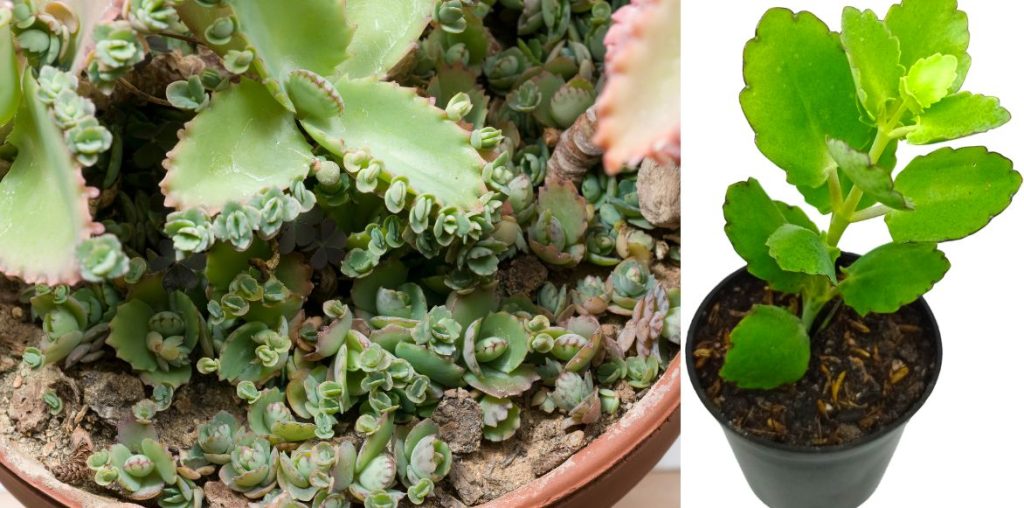
Left: young seedlings of Kalanchoe daigremontiana fall onto the substrate and root themselves. Right: a freshly rooted kalanchoe cutting.
How to showcase a kalanchoe in your home?
Kalanchoes blend effortlessly into many interior styles. Additionally, their ability to adapt to bright environments and their low-maintenance nature make them ideal plants for living rooms, bedrooms, or even offices.
Which interiors suit kalanchoes best?
- Modern and minimalist style: With their sculptural forms and vibrant colours, kalanchoes complement sleek interiors with clean lines and neutral tones. A Kalanchoe thyrsiflora, with its broad leaves and red edges, will look perfect on a light wood shelf or a white desk.
- Bohemian and natural vibe: For a cosy interior with raw materials (rattan, wood, linen), kalanchoes, particularly Kalanchoe beharensis, create a beautiful harmony with their velvety foliage and unique shapes. Placed on a wooden coffee table or hung in macramé, they enhance the natural and relaxed feel of the décor.
- Vintage or industrial décor: In a retro or industrial-inspired interior, a kalanchoe in an aged pot, terracotta, or patinated metal will add a botanical touch while maintaining a raw aesthetic. A Kalanchoe tomentosa, with its fuzzy foliage and chocolate-brown edges, will look stunning on a metal shelf or a dark wood sideboard.
- Tropical or exotic ambiance: Pairing a kalanchoe with other plants like monsteras, palms, or philodendrons helps recreate a mini indoor jungle. Varieties such as Kalanchoe marmorata, with its marbled leaves, or Kalanchoe oricula, with its compact habit, fit perfectly into a lush plant décor. You can also pair kalanchoes with plants that require similar care: agaves, haworthias, aloes, crassulas…
Which pot should you choose to showcase it?
The choice of pot significantly influences the aesthetic of the kalanchoe. Depending on the desired style:
- Raw terracotta: Ideal for an authentic and natural effect, this material highlights kalanchoes while regulating the substrate’s moisture. It suits bohemian or Mediterranean interiors perfectly.
- Coloured or textured ceramic: To energise a modern or pop space, a pot in bright hues (yellow, red, blue) or with graphic patterns will accentuate the beauty of the colourful flowers of Kalanchoe blossfeldiana.
- Wicker or natural fibre: For a cosy and warm effect, a rattan or water hyacinth planter adds a bohemian touch, ideal for complementing kalanchoes with soft shapes like Kalanchoe tomentosa.
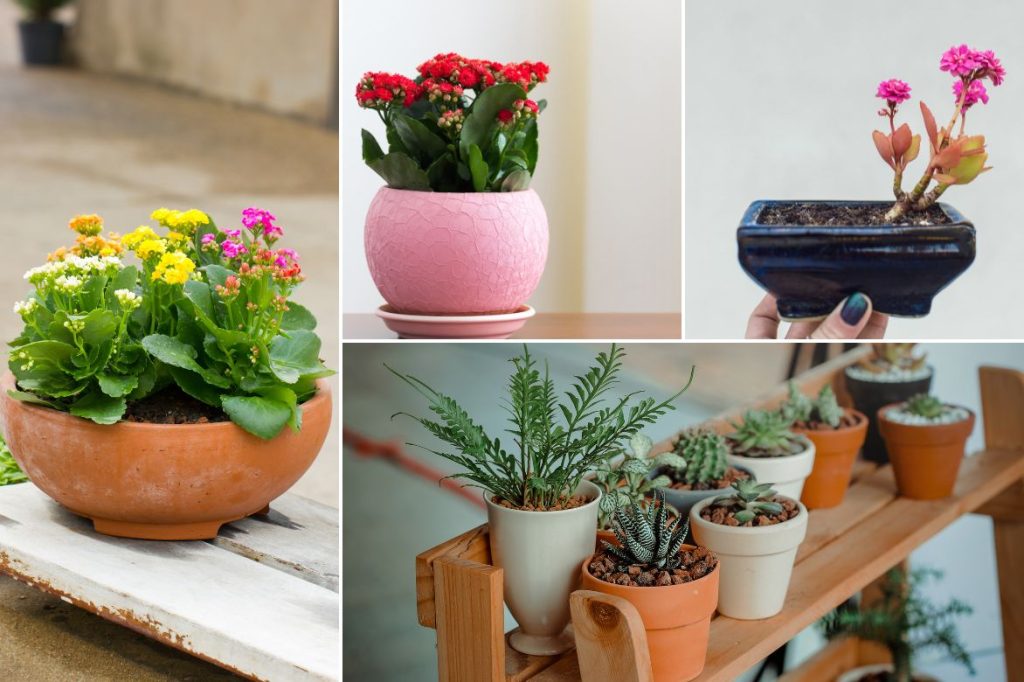
Also worth reading...
→ Discover our wide range of houseplants.
→ Many books on houseplants exist, but we recommend The Encyclopaedia of Houseplants by Solène Moutardier, published by Ulmer.
- Subscribe!
- Contents
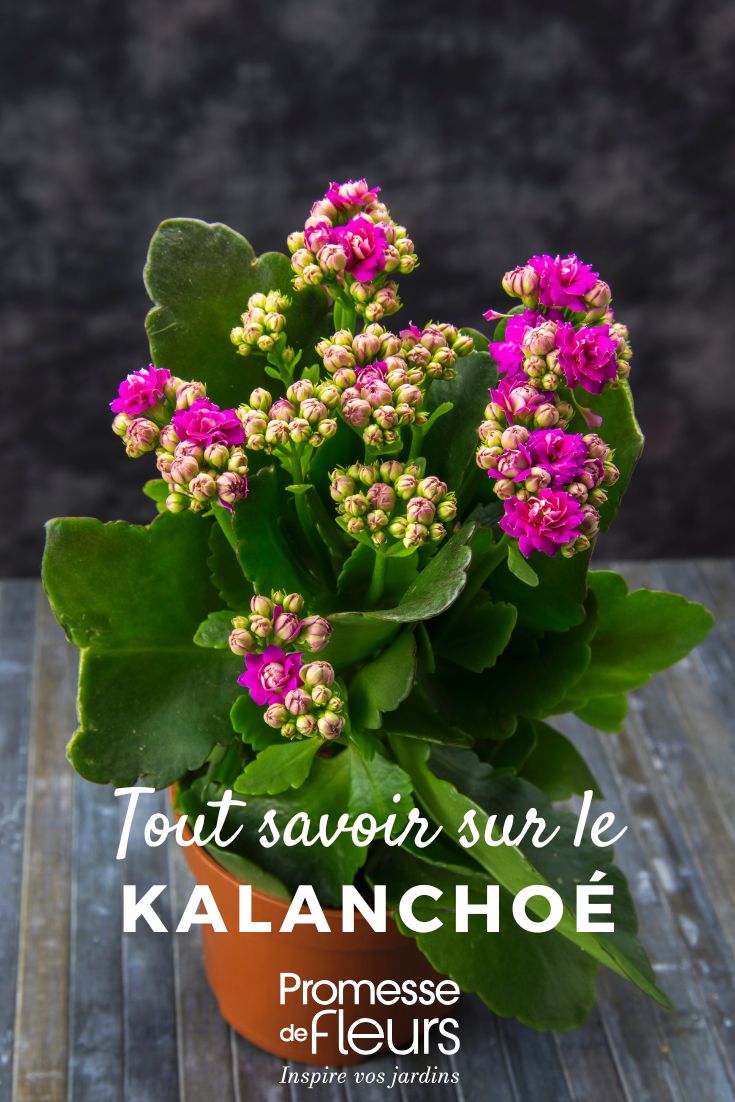































Comments